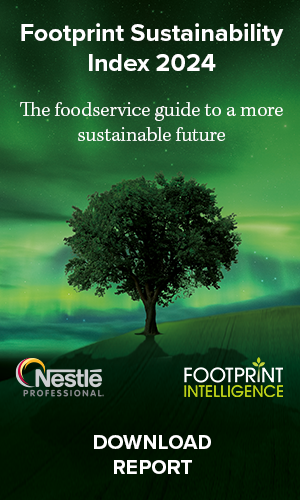The compostable packaging used in Scotland’s parliament building isn’t actually being composted, reports David Burrows.
Compostable packaging, including hundreds of cups and burger boxes used across Scottish Parliament’s estate every day, is being incinerated rather than composted, Footprint understands.
In 2011, the parliament switched to fully compostable cups and lids for takeaway coffees after an in-house audit identified that much of its landfill waste was disposable coffee cups. Then in 2017, it also switched to cutlery and other packaging made from material that can be composted, with a preference for corn starch-based products. A press release issued in February 2018 stated that the cutlery “looks and feels quite ordinary, but the signs in the café make clear that these won’t be going to landfill”.
However, Footprint can reveal that the compostable packaging ends up in an energy from waste (EfW) plant rather than being composted. The findings follow an investigation by Footprint, published last week, revealing similar issues in the UK Parliament: more than a year after first announcing plans to switch to new compostable packaging, none of the packaging has actually been composted.
In Scotland, the parliament has been using some types of compostable packaging for eight years. The compostables used on site are currently collected together with food waste by Keenan Recycling and taken to a site in Newbridge, to the west of Edinburgh, run by Enva. There the waste is “screened” ready for treatment. Changeworks, which as the parliament’s contractor oversees the process, said: “Food and compostable packaging are collected by Keenan Recycling. This is then taken to an AD [anaerobic digestion] plant, but all packaging will be removed before entering the AD process – this packaging will then be sent for recovery at an energy from waste plant.”
Changeworks explained why this is the case: “What you have to remember is that all the packaging will be mixed together – compostable or not – and by this point in the process it isn’t going to be clean and easy to differentiate. There is no efficient or effective way to separate these compostables out from the other packaging. As a ratio, there will be considerably more non-compostable than compostable packaging. This is the same reason that most composting facilities won’t actually end up processing compostable products – it’s just not practical to separate them out accurately.”
Indeed, look in detail at the parliament’s 2017/18 environmental performance report and it shows how compostable packaging volumes collected with food waste had become unmanageable. It reads: “During 2017/18 our waste contractor alerted us to the fact that the amount of compostable packaging we were disposing of alongside our food waste was too much in volume compared to the amount of food. This has issues when it comes to the transfer of food and compostable packaging to the anaerobic digester, where it is composted on an industrial scale.”
Scotland’s parliament tried to solve the problem last year by collecting compostable packaging separately from food collections and sending it directly to be incinerated. This trial was unsuccessful, however, so it has now returned to collecting food and compostable packaging together. “On face value compostable packaging is fantastic, but look into it and it’s not as positive as you might think,” Ken McLean, operations director at Changeworks, told us. Incineration of compostable packaging, producing heat and energy, is “the most sustainable outcome, as this packaging is inherently mixed with non-compostable packaging when screened at an AD or composting plant, and cannot be separated from each other”, he added.
As long as AD and composting plants have a requirement to pre-screen food waste, then it’s likely that compostable packaging won’t end up as compost. Most AD plants would struggle to process even a clean stream of compostables in the digester, for example. Linda Crichton, part of DEFRA’s waste policy team, recently hinted that compostable packaging may well have to be both compostable and digestible in order to align with the UK’s AD infrastructure. A call for evidence on standards for bio- based and biodegradable products is expected soon.
Speaking at the recent The Future of Compostables in Packaging event in London, WRAP’s resource management specialist Helen Bird raised concerns about whether the materials could work at scale within the current infrastructure. Experts at Ricardo Energy & Environment recently predicted that the UK could increase the uptake of compostable packaging to between 90,100 and 138,000 tonnes per annum, but questions remain as to where it will all end up.
Changeworks said that despite the issues with compostable packaging they are “not just for show”, with parliament’s decision to switch also due to the “upstream (production) benefits and renewable sources. Their disposal along with food waste […] helps to reduce the likelihood of contaminating their other, established recycling streams.” A parliament spokesperson said the preference for corn starch-based packaging “shows we are serious about using sustainable materials and discouraging single-use plastics”. The Holyrood parliament building has around 1,000 staff working there and some 300,000 visitors a year, and all are encouraged to use proper cups, plates and cutlery, “which means less and less compostable packaging gets sent for anaerobic digestion”, he added.
Compostable single-use cups, for example, are available on site but discouraged by price – on average, 36 cups were used every day in May. More than 260 compostable burger boxes are also used daily across the parliament estate. Add in cutlery and other forms of compostable packaging and this amounts to tens of thousands of single-use compostable packaging items being burnt every year.
Last week, Footprint revealed that large volumes of new compostable packaging from the UK Houses of Parliament are also being sent for incineration due to shortcomings in the waste supply chain. Some £68,000 a year is being invested to develop its own separate waste stream for the compostable packaging. But McLean at Changeworks said “it would not be sustainable to collect used compostable packaging separately and send that independently to a composting plant”.
Indeed, he maintained that Scotland’s parliament is one of Changeworks’ leading clients given its record on recycling. “They might not get it right every time but they are leaders, and if every business was like parliament we’d smash our waste targets.” Scottish Parliament’s 2017/18 environmental performance report showed 76% of the waste was recycled or composted. This was down from 89% the previous year, and compostable packaging was to blame. The report states: “This move of compostable packaging waste going directly to be incinerated had an impact on our recycling and composting figures, meaning we missed our targets significantly.”
Footprint’s revelations this month highlight the challenges faced by organisations in ensuring that compostable packaging is being disposed of in the most responsible way. It also raises questions about extended producer responsibility, which is the focus of a government consultation in Westminster. The struggles are embarrassing for policymakers and the industry, especially when the general public holds compostable packaging in such high esteem. In a recent survey by The Grocer, consumers ranked a range of materials on their sustainability and plant-based compostables came top, well above paper and glass. Compostability was also considered more important than reuse and refillability.
McLean, who expressed concern about the repercussions from revelations regarding the final destination of compostables (which also include one by the BBC in February showing that Welsh councils were unable to deal with compostable material and were sending it to landfill) said that in the grand scheme of things, the arisings of compostable packaging is tiny: “It’s a ‘fringe material’. However, in the public eye it’s become a big issue. We struggle with managing the confusion around issues such as these – small in impact but large in the public consciousness.” He added: “[Compostable packaging] is not a bad thing; it’s just not as good as people believe. The sustainable approach is to eliminate single-use, not substitute it with compostable.”
The Scottish Government, not to be confused with the country’s parliament, banned single-use cups from its canteens last June. In London, meanwhile, the UK Parliament introduced a 25p surcharge on all hot beverages to encourage customers to instead use a china mug or a reusable “keep cup”. The measure has resulted in a reduction in monthly sales of hot drinks in single-use disposable cups from 58,000 to 15,000 with no negative impact on overall sales.
Additional reporting by Nick Hughes.














